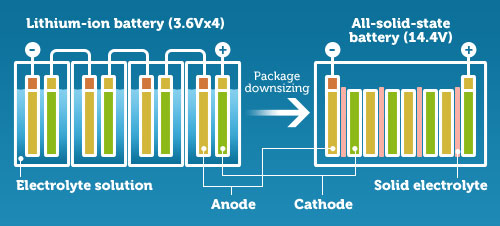Musashi Seimitsu Industry, a Japanese automobile parts manufacturer, and advanced battery technology specialist KeraCel have formed a strategic partnership to accelerate the development of 3D printed solid-state batteries.
As part of this partnership, Musashi has made an investment in KeraCel to advance its 3D printed batteries toward high volume production. Together, the partners will focus primarily on the motorcycle industry, and then adapt to technology for the wider automotive sector. “Partnering with Musashi,” says KeraCel Chairman and CEO Robert Bagheri, “enables KeraCel to develop safe, high energy batteries for the automotive market.”
Solid-state batteries for motorcycles
Solid-state batteries differ from standard lithium-ion counterparts as they replaces the liquid or polymer gel electrolytes with a solid. This results in batteries that are smaller, higher-capacity and potentially safer to use. The many benefits offered by solid-state batteries have led many major automotive companies, like Toyota, BMW and Honda, to develop akin solutions for their electric vehicles.

Founded in 2016, KeraCel is developing and bringing to market a solid-state battery manufactured using a proprietary 3D printing method. The solid material used in KeraCel batteries is ceramic. In KeraCel’s method ceramic layers of material are incredibly thin, reducing the amount of inactive material overhead, and increasing the potential energy density. As a result, the battery is said to have achieved double the energy at half the cost compared to today’s lithium ion batteries. 3D printing also allows KeraCel to manufacture the battery in any shape or size in order to fulfill a multitude of applications.
Musashi’s investment in KeraCel 3D printed battery technology aligns with the company’s vision of driving sustainable energy and growth while conserving the environment. “We are excited to explore the technological innovation for solid state batteries together with KeraCel,” commented Hiroshi Otsuka, President and CEO of Musashi Group. The partnership also comes at a time where vehicle manufacturers are put under increasing pressure to reduce their carbon footprint.

3D printed batteries
Multiple different approaches to solid-state battery production are currently being tried at various research institutions. In 2018, scientists from Carnegie Mellon University (CMU) and Missouri University of Science and Technology applied 3D printing to produce high capacity lithium-ion batteries. At the time the research was deemed “a major advance in 3D batteries” by the study’s authors, with the potential to transform all portable electronic devices, from smartphones to laptops and games consoles.
Using a desktop 3D printer and PLA filament, researchers at Texas State University and Duke University, North Carolina, also found a cost-effective way of fashioning lithium-ion batteries into wearable devices and coin cell batteries.
Recently in 2019, Lawrence Berkeley National Laboratory researchers 3D printed an all-liquid device to be used in the chemical synthesis of batteries and drug formulations.
Subscribe to the 3D Printing Industry newsletter for the latest news in additive manufacturing. You can also keep connected by following us on Twitter and liking us on Facebook.
Looking for a career in additive manufacturing? Visit 3D Printing Jobs for a selection of roles in the industry.
Featured image shows Zero electric motorcycle charging. Photo via Zero Motorcycles.

